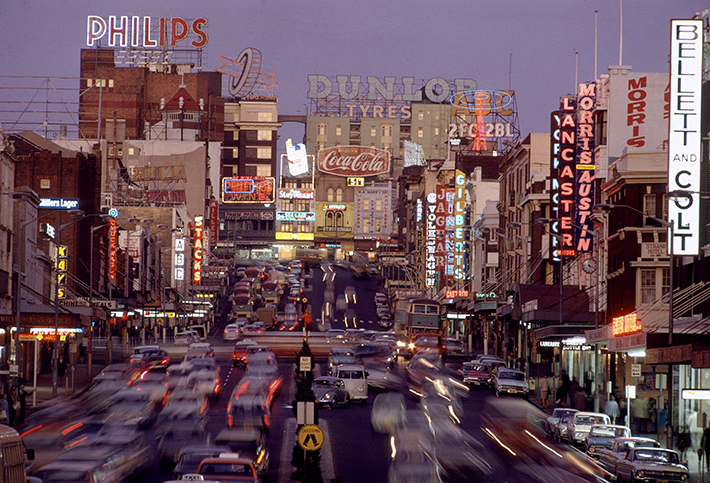Sydney Portfolio

William Street, Sydney – 1966
David Moore was to discover what he termed the ‘magic’ of photography on receiving a Coronet camera for his 11th birthday. What the camera delivered to his youthful imagination changed forever a presumption that he would follow in the footsteps of his architect father John D. Moore. Moore senior had a second string to his bow: recognition as a celebrated painter, Australia’s first significant water-colourist. For David it was a double legacy to be envied: an appreciation of the discipline of built form, of its potential for beauty and drama, and a sensibility grounded in the powers of observation together with a visual acumen, an unerring eye and a quick-wittedness primed to capture the fleeting moment.
Born in Sydney in 1927, Moore grew up on the Harbour’s eastern edge, a handy vantage point from which to view the city, its environs, its shipping traffic. Once armed with a camera he recorded his immediate world with enthusiasm, photographing his friend on a bike, his brother, seagulls on the beach at Manly, the view from his house, big game-fish hanging from the gallows at Watsons Bay, the Archibald Fountain at Hyde Park, the Catalina flying boats at Rose Bay and the city shrouded in early morning mist. Simple and naïve, his shots represented a useful learning curve. They also established the beginnings of an appropriation of the city as his private palette and singular beguilement. It could be said that Sydney was worming its way into his DNA.
When Moore took his love affair with his hometown to its harbour and streets, he gave as much attention to the distressed areas of Redfern, Edgecliff, Alexandria and Paddington as he did to the well-to-do city streets. The former was motivated by his admiration for the work of American photographers Walker Evans (1903-1975) and Dorothea Lange (1895-1965), both of whom contributed to the rise of photojournalism, an area that was to entrance Moore in the 1950s. The latter involved captivation to an aura of wealth and excitement in the business centre of Martin Place where he would sneak to the highest vantage points to capture the soaring colonnaded neo-classical facades that dwarfed the pavement crowds.
The images Moore produced while still in his early twenties remain some of his finest. Certain of them, including Redfern interior (1949) and Sydney Harbour Bridge 2 (1949) have become classics – icons imprinted on Australia’s visual memory. And despite his extensive travels, Sydney remained the place he preferred in order to keep exploring and experimenting with new ideas.
For enquiries about these photographs please email Lisa Moore, or Josef Lebovic (Josef Lebovic Gallery).